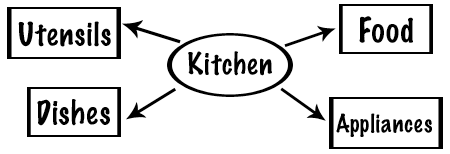Guidelines on Selecting Words for Instruction
- Less is more …choose fewer words and go for deeper understanding.
- Choose terms that are central to the theme or unit content.
- Choose key words that relate to key concepts or ideas.
- Choose words that will be used repeatedly and form a foundation for other knowledge.
Students learn vocabulary more effectively if they are engaged in constructing meaning rather than memorizing definitions or synonyms. Webbing can be used to help students build on personal experiences and background knowledge. The teacher may start with a word that is familiar and put it in the center of an organizer such as the one shown below. Students participate by offering words associated with a central term. To extend knowledge of word relationships, the students may then generate other words and list them under each of the categories. This is called semantic mapping.

Concept mapping can also help students engage in vocabulary learning by asking them to answer questions about terms.
- What is it?
- What is it like?
- What are some examples? What is not an example of concept mapping?
These elaboration techniques are from the Content Enhancement Series from the University of Kansas Center for Research on Learning.
- Teach terms in a meaningful subject-matter lesson and facilitate discussion on new terms.
- Paraphrase the new term's definition to express its main idea and the critical features of the term.
- Make background connections to the new term by relating it to previously learned content or familiar ideas or concepts, relating it to personal experiences, or relating it to understanding or solving a real-life problem.
- Identify examples and applications as well as the opposite. The student must explain the connections.
- Create multiple opportunities for students to elaborate the meaning of new terms.